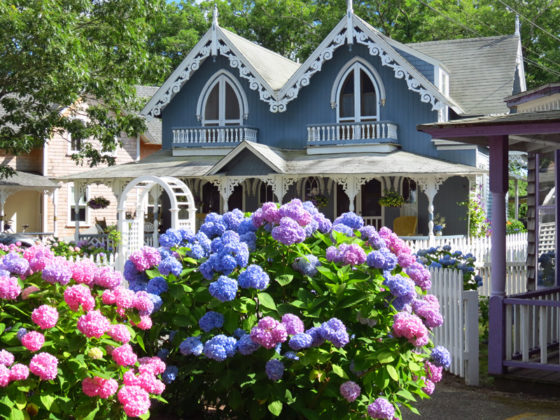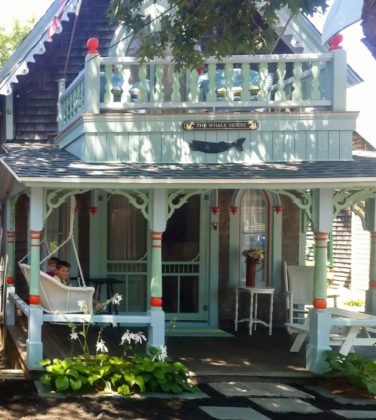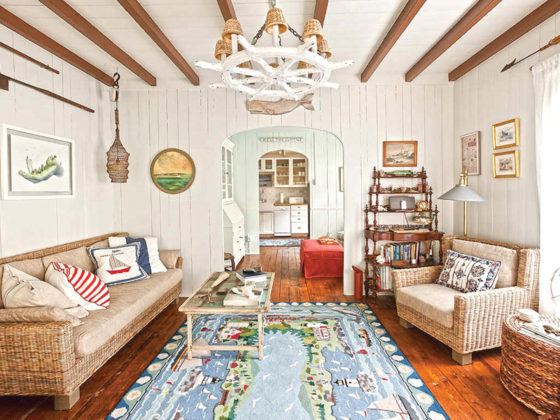Brightly colored and intricately carved trim adorns many of the houses in Oak Bluffs. The epicenter of this style is the Martha’s Vineyard Camp Meeting Association (MVCMA), a unique neighborhood that has charmed visitors for over a century and a half. “All the houses are bright little painted boxes of fairy-looking cottages,” and, “What a wonderful collection of tiny houses strewn about helter-skelter, like toys forgotten by children,” wrote two visitors in the late 1800s in “City in the Woods” by Ellen Weiss. Here, the streets are walkways, neighbors gather on porches, and a feeling of peaceful community prevails.
The gingerbread architectural style emerged around 1860. Since the 1830s, Methodists had gathered in the grove here for summer revival meetings. They lived in tents, and at the revival’s peak, there were as many as 500 tents on platforms, with canvas stretched over wooden frames. When the Civil War began, there was no canvas available, because it all went to the military. The campers began enclosing their tents with vertical boards when their old canvas wore out, and they shaped the windows to look like those in their home churches, complete with colored glass.
Around the same time, the bandsaw was invented. This enabled the Island craftsmen to cut fanciful shapes out of wood: scrolls and flowers, abstract patterns and animals. There was a bit of competition, a “who can top this?” kind of feel, according to Dawn McKenna, interim general manager of the MVCMA. She and her husband, Stephen, live here year-round, and he is an expert in the Campground’s history. They can point out the oldest house on the central circle, built in 1859, and others that are notable for various unique features. One was built for a family of little people who worked in a circus — its light switches are low on the wall for those original residents. Another is still owned by the same family that built it, seven generations later.
Lois Bell Mayhew hasn’t been here from the beginning, but her family, the Bells, bought a cottage here in the late 1950s. Lois’ father was a Methodist minister, and the family that had built the house was eager to sell it to them to help keep the Campground’s Methodist heritage alive. “When I was growing up there in the summers, the families were all friendly,” Lois says. “Each summer you would return there and see your friends. We would meet at the beach and ride our bikes around.” Lois married a man from up-Island, who was skeptical about staying in such a crowded place. “My husband didn’t think he could take it, all the people, but he loved it,” she says. “He’s a gabber. My son loved it because he could have his up-Island friends over and they could walk over to Circuit [Avenue] and grab a pizza.”
The cottage has its quirks. When the Bells bought the house, the toilet was on the back porch in its own little enclosure. There was a similar arrangement at the cottage that Tracey Overbeck Stead and her husband bought in 2008. “We uncovered the original heart-shaped hole in the wall from when the toilet was like an outhouse,” Tracey says. “It just went down into a hole in the ground. There were toilets from the turn of the century that were holding up the house. It hadn’t been touched for many, many years when we got it.” Meanwhile, the Bells’ house still has its original kitchen sink, made of cast iron, which rusts. “The guys love it because it’s large and it’s long, so you can clean fish in it easily,” Lois says, but it added to the chores of closing up for the winter. “My mother’s job was to coat the sink with Vaseline for the winter, so it wouldn’t rust. My job was to wax my bicycle, to store it upstairs for the winter.”
Some of the cottages are winterized, but about 85 percent of them are empty during the winter months. Closing up the summer cottages means bringing the porch furniture into the living room, because there’s no room here for outdoor storage. The houses are so close that in many places you can reach out from the porch and touch the neighbor’s house. Lanterns for Illumination Night are tucked away, too, some of them nearly as old as the houses themselves.
The closeness of the neighborhood is a quality that’s cherished by its residents. Kids play outside, teenagers walk to the arcade or the beach, and adults don’t need a car to get to the grocery store. Lois’s children bring their kids to visit from up-Island, and her off-Island siblings come with their children and grandchildren, too. “It’s very Norman Rockwell. It’s what people would consider the good old days, where your neighbors take care of you,” says Tracey. When her children were little, she recalls sitting on her neighbors’ porch and letting their children play in the living room, only a few feet away. Her mother called, alarmed to see the children unsupervised, via the security camera that Tracey had installed, as everyone did in her former hometown of Austin, Texas. In the Campground, the neighbors’ eyes are everyone’s security cameras. “Family is such a huge part of the Campground that they really look out for kids,” Tracey says. “It’s really sweet living there in the summer.”
Tracey works as an interior designer, and embraced the challenge of fixing up her cottage, working with the creative constraints that came with the old structure and the MVCMA’s regulations. “When we think about design — because I’ve also done a few cottages for others in the Campground — we start off with a plan, with these ideas in your head, but it has to change,” she says. “The cottage is the one in control, and you have to listen to her. They have little treasures hidden within them. As you take a little bit out and put a little bit in, you uncover things.” The structure of the house itself amazed her. “During this whole restoration, we realized that the house was off by maybe ¼ to ½ inch. That’s just unheard-of these days. They look fragile, but they’re so incredibly tough and strong.”
As you visit, remember that although the gingerbread is charming, wood and paint are not a good snack, and the fairyland look is preserved by cottage owners who must meticulously maintain these antique houses. The cottages are narrow, built on plots and platforms originally laid out for canvas tents, but the closeness helps to create a kind of community that’s almost as hard to find as the fairyland feel that the Campground evokes.











